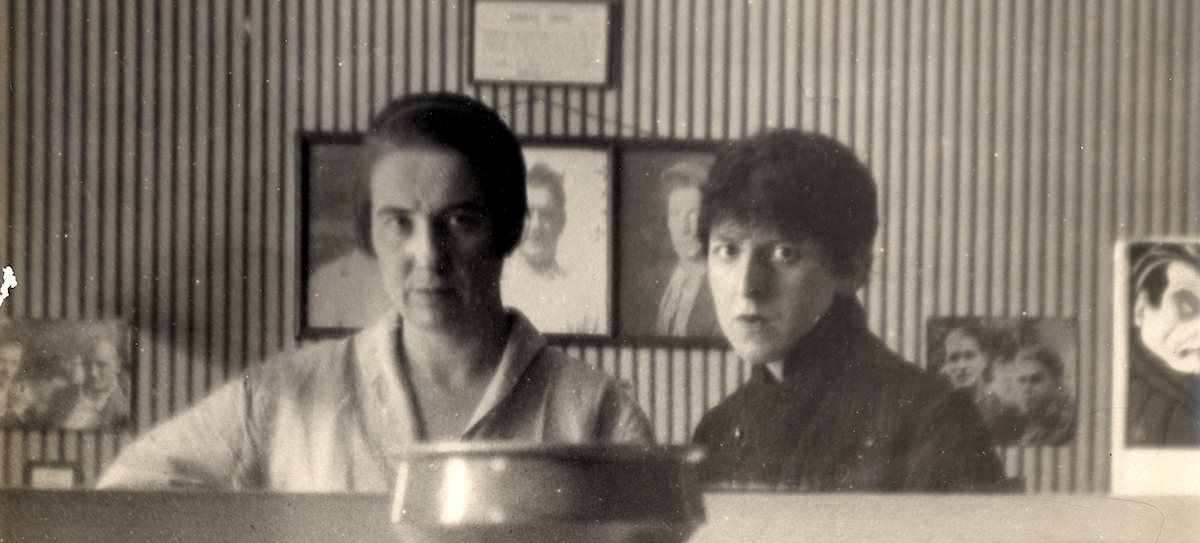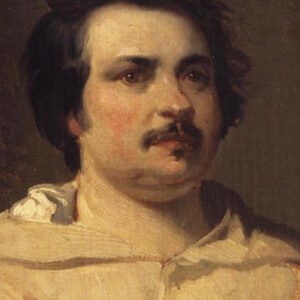Creativity may be hard to define, but it’s sometimes even harder to attribute. The museum mistaking a minor work for a masterpiece or the collector discovering a forgery may measure provenance in millions. Yet solving mysteries around authorship reveals something even more valuable about how innovation actually works. Sometimes the myth of “artistic genius” hides a more complicated story.
Suzanne Malherbe and Lucy Schwob, two early 20th century French avant-garde artists have presented this dilemma. Was one the visionary and the other merely an aide to greatness? That’s often how biographers present them, portraying Lucy as a powerful intellectual forging new artistic directions but relegating Suzanne to little more than a useful helpmeet. Museums, galleries, and websites laud one, but largely ignore the other when displaying their work. However, a fuller understanding of their lives makes clear that their entire oeuvre—from 1920s and 1930s photographs now seen as groundbreaking to their four-year anti-Nazi resistance campaign—could only have emerged from the intimacy of their romantic relationship. Overlooking the connection between love and art, and the equal partnership at its core, skews our understanding of what they accomplished together.
Just after World War I, Suzanne and Lucy relocated to Paris. The move came as these young women in their twenties were crafting new artistic personae. They donned gender-neutral names a few years earlier, and heading to the City of Light offered a further opportunity to express gender fluidity. Suzanne became Marcel Moore, and Lucy became Claude Cahun—Claude, in particular, was a name used by both men and women in France. Paris, freer than their hometown of Nantes, hosted a thriving gay scene and the chance to live openly as a couple. It brought inspiration through friendships with Salvador Dalí, Jean Cocteau, Gertrude Stein, and communist activists. The women’s apartment became a gathering place for like-minded bohemian souls.
In many ways, they were opposites. Moore was personable and outgoing: “firm ground, calm and light ocean,” as one friend summed her up. Cahun was laconic and introverted, often seeking solitude. The same friend called her “tormented sky, deep agitated ocean.” Cahun suffered from chronic illnesses and sometimes sought relief through drugs, yoga, fasting, and astrology. She frequently contemplated suicide. The more practical Moore, lovingly devoted to Cahun, took good care of her partner. Their relationship became even more intimate when Suzanne’s widowed mother married Lucy’s divorced father, making the two stepsisters just as they were falling in love as teenagers.
Each had an eye for pushing the boundaries of gender, cutting her hair short and dressing in a mix of men’s and women’s clothing even though cross-dressing was technically illegal in France. One night, Cahun might don an evening gown with heavy pleats, and on another a star-studded jacket with a shirt and tie. She accessorized with a muslin veil or a gray felt hat, pairing expensive high heels with thick velvet pants. In colder weather, they both preferred bulky Burberry overcoats.
Their art provoked audiences to reconsider what it meant to look like, or to be, a man or a woman.Work paralleled life, and their art provoked audiences to reconsider what it meant to look like, or to be, a man or a woman. Moore’s illustrations embraced the “boyish” look, and Cahun’s stories and essays detailed women taking on masculine roles. Photography became their chief collaboration and the medium where they would leave their historic mark. Playing with dress, pose, hairstyle, and expression when she stepped in front of the camera, Cahun reinvented herself each time Moore clicked the shutter. Dozens of their sometimes fantastical, sometimes funny photographs exposed gender as a kind of masquerade. The work still inspires—Dior created a 2018 fashion line based on their imagery—as much as it arouses. David Bowie, well known for his own gender ambiguity, mentioned a 2007 show of their photography on his blog: “I find this work really quite mad, in the nicest way.” Cahun in particular—because she appears in the photographs as a fractured, fluid self, showcasing multiple identities across gender lines—has now come to be seen as a queer hero. Others find in her image a pioneering transgender figure.
But this is where the question of authorship arises. Who created these photographs that continue to resonate?
Amongst the creative class in interwar Paris, there was never any doubt that Moore and Cahun were collaborators in both life and art. They almost certainly staged the photos together and then decided which exposures worked best. Yet few outside that scene knew them. Both came from wealthy families, so neither was a “starving artist” selling her work to make a living. Only a handful of the photographs they produced were shown or published during their lifetimes. The sole “exhibition” of their photography was a Montmartre window display advertising the launch of Cahun’s autobiography. Integral to each chapter was a different—often disturbing, sometimes violent—photomontage that captured the feelings Cahun described. But inside a book only printed in a run of 500 copies, they hardly reached a wide audience.
The women departed Paris in 1937, relocating to the island of Jersey in the English Channel, their longtime vacation spot. Cahun’s illnesses were catching up with her. Paris had become more politicized with crackdowns on the gay community and right-wing extremist groups cheering Hitler and Mussolini. As they faded from the Paris art scene, sailing to Jersey on a ferry from the Norman coast, so did their story.
What is today their most famous, and widely reproduced, image was taken in 1927, likely in their Montparnasse apartment. Cahun appears as a genderless figure looking over her shoulder, her body hidden beneath a bulky Harlequin-patterned coat. Her hair, cut short in a masculine style popular in the 1920s, shimmers with a metallic dye. Her skin, bronzed with theatrical paint, nodded to the experimental shows in which both women participated.
In the background, a framed photograph sits on top of a dark wooden dresser. The figure in that image appears to be Moore, but typically when the photo is reproduced in books or articles, the dresser—and Moore’s picture—gets cropped out. In exhibitions, biographies, and scholarship, this photo, like nearly all of their work, is attributed to Cahun alone.
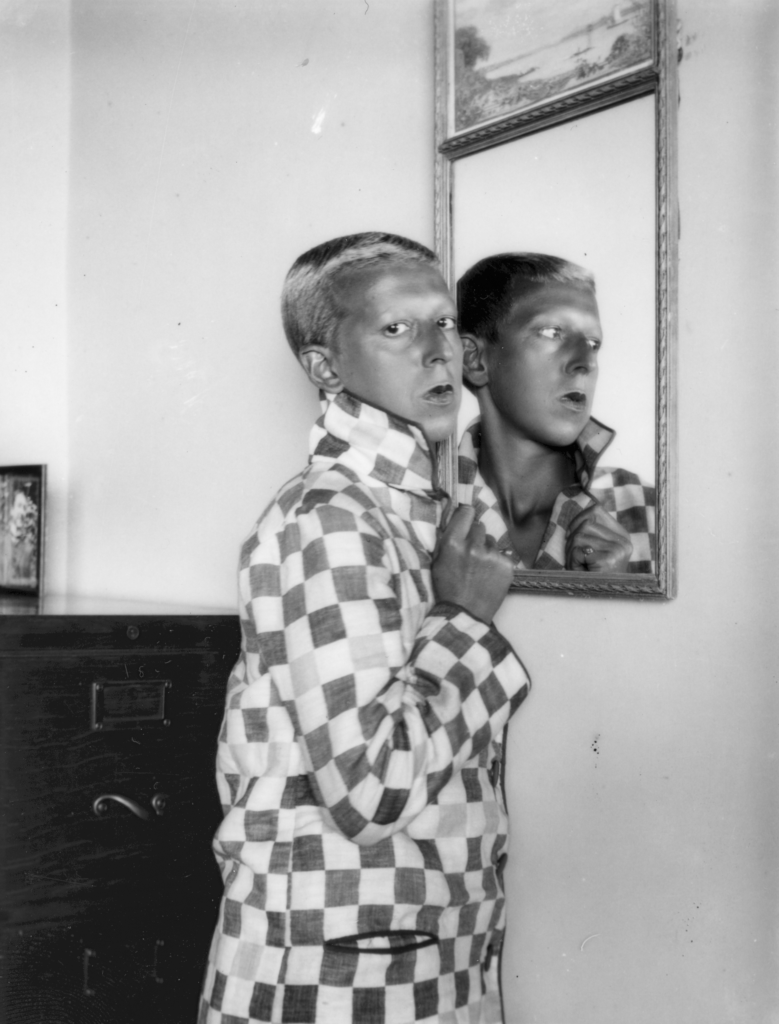 “Self Portrait,” by Claude Cahun, 1928. Photo courtesy of the Jersey Heritage Collections
“Self Portrait,” by Claude Cahun, 1928. Photo courtesy of the Jersey Heritage Collections
The dilemma of attribution begins with how the photographs were re-discovered. In the 1980s, French philosopher François Leperlier encountered their work by chance in an old publisher’s catalogue and believed the artistic vision to be Cahun’s. The fact that she had famous relatives provided a paper trail of family history to follow.
Leperlier’s 1992 biography of Cahun established the belief that she was the energy behind the images, but others reinforced it. In her bold poses, everyone believed they could see the genius in Cahun’s eyes and body. Scholars likened the photos to those of Cindy Sherman, the feminist photographer whose 1970s images challenged how women appeared on film. Sherman was clear about creating every aspect of her work, from the disguise she wore to the framing of the image. By comparing Cahun to Sherman, critics implied that the two shared an identical process, even with no evidence to support the claim.
A love story was at the heart of Suzanne and Lucy’s entire body of work—from photographs to notes for the Nazis.As Cahun’s story came to be told and retold, Moore’s role slipped away. At best, she became the supportive partner, or a mere assistant. This, despite Moore’s art school training and career as a working visual artist, while Cahun always described herself as a writer. (Neither had training in photography and only ever used one camera; they owned no studio lighting and relied on commercial photo labs.)
Yet clues in their artwork pointed to Moore’s much larger role. At least one of the photomontages is signed by Moore, and Cahun repeatedly wrote about their work as a collaboration. Art publications and interviews in the 1920s and 1930s referred to their rich creative partnership.
But Moore was off-camera, so she remained invisible.
In Powers of Two, Joshua Wolf Shenk highlights the pair as the historic agent of innovation. Intellectual sparks fly in the back and forth between two people, Shenk notes, and he concludes that the duo is “the primary creative unit.” Sometimes one partner seems to be “off-stage,” but in fact one is the “director” to the other’s role of “star.” That certainly describes Moore and Cahun—one the performer in front of the camera, and the other an off-camera, yet no less important, artistic voice.
One of their photos makes this director/star dynamic visible. Cahun wears a black wrap covering her torso. A choker presses around her neck from which hangs a beaded Star of David, in homage to her father’s Jewish heritage. Faintly, with eyes barely visible in the upper left-hand corner of the photograph, Moore peers over the backdrop.
But only Cahun fits our stereotypical image of the “bohemian artist.” Critics often categorize her self-interrogating writing from the 1920s and 1930s as Surrealist, a perception echoed by one of the movement’s founders. André Breton told Cahun, “You are well aware that I consider you one of the most curious spirits… of our times.” Cahun took risks on the page, so it seemed logical that the avant-garde writer also conceptualized cutting-edge photography. Moore’s beautiful art nouveau and art deco illustrations from that period broke no new ground. Cahun—chronically ill, kooky, an introvert with a troubled childhood—came to be seen as the “artist” while Moore—the down-to-earth, caretaking, practical one largely behind the scenes—seemed to be an imitator.
*
When they headed for Jersey in 1937, the women returned to their birth names. Suzanne (Moore) and Lucy (Cahun) gardened and read at their farmhouse, built out of local brown granite overlooking the beach where they swam. Their back door faced south toward France and the life they left behind.
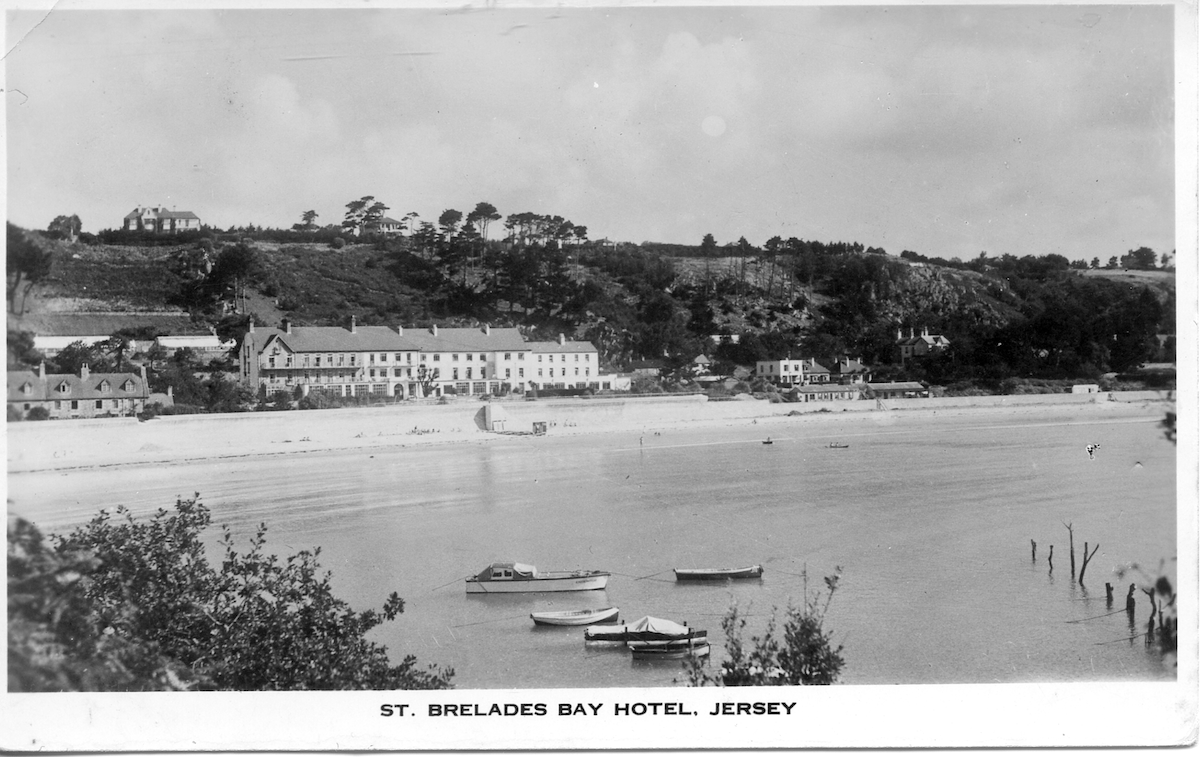 Photo courtesy of the Jersey Heritage Collections.
Photo courtesy of the Jersey Heritage Collections.
Only few years into this quiet life, the women found themselves in an unthinkably dangerous situation. In June 1940, the German army arrived on the Channel Islands, the only British territory they conquered. Luftwaffe planes strafed and bombed the defenseless archipelago. When a Nazi officer landed at the Jersey airport, the island’s leader could only shake his hand in surrender.
Suzanne and Lucy hated everything the Nazis stood for and protested the rise of Hitler and during the 1930s. They flirted with fascism’s mortal enemy, communism, during their Paris years, and Lucy had honored her Jewish family at a time of growing anti-Semitism. So instead of hunkering down, these women chose to fight back. The choice was hardly surprising, since they had been resisters all their lives.
Suzanne and Lucy devised a strategy of quiet defiance. For four years, they wrote hundreds of German-language notes to undermine the troops’ morale. These “paper bullets”—songs, poems, bits of dialogue, bawdy jokes about Hitler, summaries of BBC news reports—sometimes included drawings or snippets of a fake secret code. Cafe tables around Jersey, German staff cars, and fence posts became drop sites for their missives. They tucked some between pages at the newsstands. They inserted others in bottles thrown in the bay. Suzanne slipped notes into the pockets of unsuspecting soldiers. With thousands of troops on Jersey, more people likely saw these creations than had ever encountered their art back in Paris.
 Photo courtesy of the Jersey Heritage Collections.
Photo courtesy of the Jersey Heritage Collections.
This daring PSYOPS campaign sought to drive a wedge between soldiers and leaders, demoralizing the Germans and encouraging them to desert. Real men would take care of their families, these messages proclaimed, not stay on Jersey. To make them seem authentic, the women again crossed gender lines, assuming the identity of a fictional German soldier they created called “The Soldier With No Name” and signing the leaflets with his moniker. They always carried a little bottle in the pocket of one of their Burberry overcoats with a drug overdose in case they were caught. They had suspicions about what the Germans might do to them.
In 1944, the Secret Field Police did arrest Suzanne and Lucy, and a court-martial sentenced them to death. For eight months, they remained behind bars until VE day, when the Germans released them only minutes before surrendering.
*
In 1954, Lucy succumbed to a kidney tumor and the chronic illnesses exacerbated by her time in solitary confinement during the war. When Suzanne killed herself in 1972, what remained of their belongings were auctioned. As the buyer hauled off the crates, some of their papers began flying away, and few were already being swept into the garbage.
The remaining sources recording Suzanne’s and Lucy’s lives are scattered. Many are in Jersey, and others at Yale University. The documents reveal their resistance in exacting detail, including the trial and life behind bars. Both women filled pages with the slow drip of memory after the war, sometimes scrawling remembrances on the back of an envelope or a calendar. One set of papers contains a series of disconnected sentences and orphan phrases, each with a line drawn underneath. Then, below the line, another thought unrelated to the one above, another line, and so on. Most of the surviving notes are not signed.
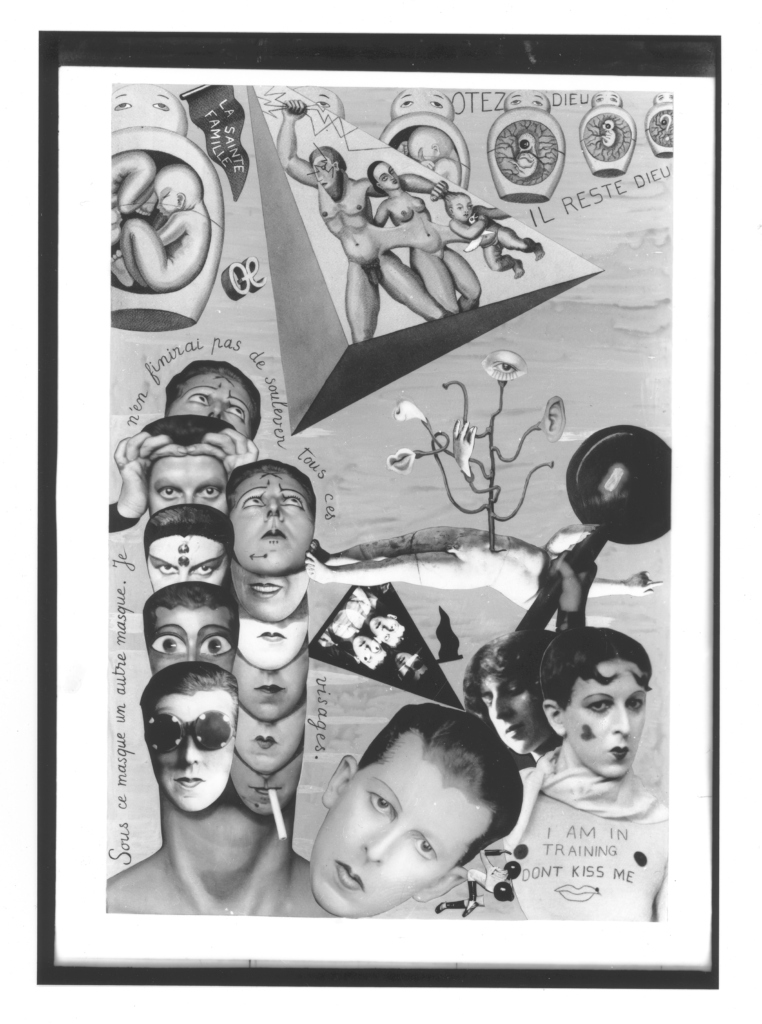 Image of photomontage illustration from Aveux non avenus, ca. 1930. Courtesy of the Jersey Heritage Collections
Image of photomontage illustration from Aveux non avenus, ca. 1930. Courtesy of the Jersey Heritage Collections
Without clear authorship, these documents have enabled biographers telling the story of their resistance once again to push Suzanne to the sideline. Just as with their art, Lucy gets moved front and center in the narrative. The creative force behind their photographs, the reasoning goes, must also have been the mastermind of an audacious anti-Nazi plot.
But if these two minds were working in conjunction, surely Lucy could not have done this work alone. A detail in a surviving description of the night of their arrest on July 25, 1944 revealed an important clue. After four years of targeting clandestine messages toward the Nazis, Suzanne and Lucy expected they would get caught, perhaps even betrayed by a neighbor. One night, the Secret Field Police pounded at the door and frantically searched for incriminating evidence.
The words now in the archive recount an exchange between one of the women and the agent directing the raid. Then on a page browned by age and filled with blue ink, a phrase written at the top stood out: “While Lucy was in the bathroom.”
This small annotation and supporting details in the story made clear that these were Suzanne’s words. Recognizing her handwriting allowed me to distinguish between the women’s documents. I could disentangle these lives woven together for decades in order to tell their history more fully. The more I read, the more I realized how central Suzanne’s role really was.
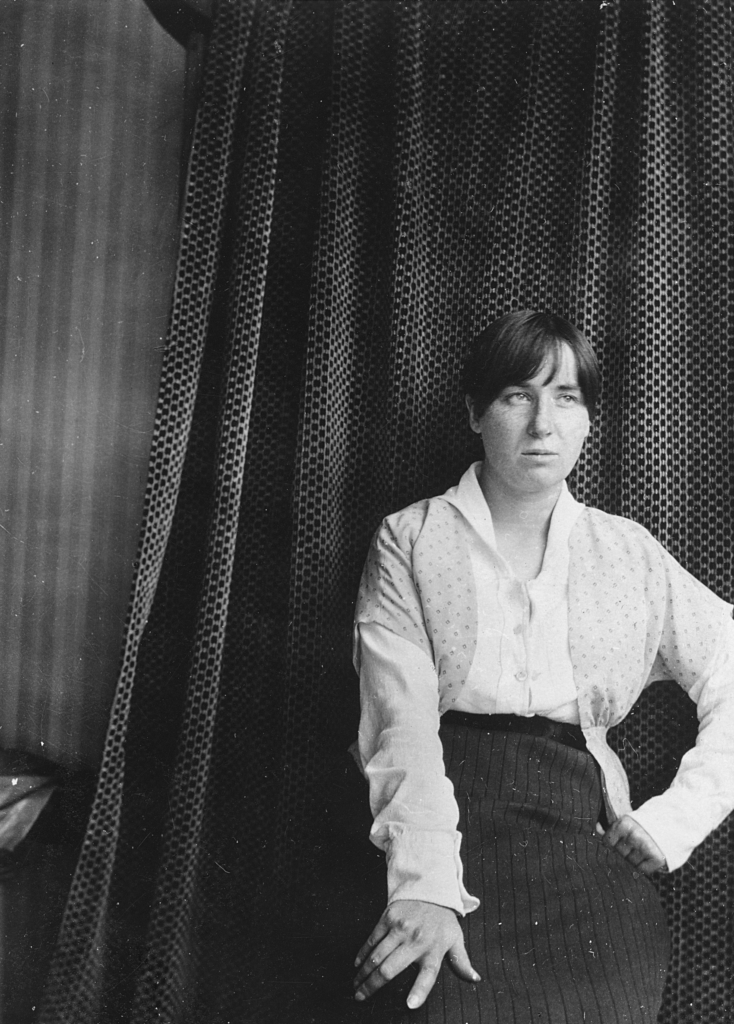 Suzanne Malherbe, also known as Marcel Moore. Photo courtesy of the Jersey Heritage Collections.
Suzanne Malherbe, also known as Marcel Moore. Photo courtesy of the Jersey Heritage Collections.
Suzanne began to rise from the page and take shape as words revealed her personality, dry humor, and pragmatism. Sarcastic backtalk to the German officer presiding over the court-martial and mockery of their ineffectual lawyer made far more sense coming from her than from Lucy. Of course, it was a kind of performance. Suzanne shaped these words, not only for herself but for readers she was never able to reach. But once individual authorship was clear, the women’s joint narrative came into focus.
When the Nazis interrogator asked Lucy about her responsibility for their “crime,” she replied, “I alone was the cause of all this…. I wrote all the texts.” These words in Lucy’s post-war account have led some to believe that she was the genius behind their resistance. In fact, Lucy’s admission was a lie calculated to get Suzanne off the hook. The most important part of her “confession” followed: “It was more often me who accompanied Suzanne, she who took the initiative that required the most sang froid.” When the soldier asked her to explain some of their notes, Lucy just shrugged her shoulders. Suzanne, not Lucy, spoke his language.
Biographies of artists and writers frequently miss the intimate relationships where collaboration happens.During that interrogation, Lucy announced, “I am, on my father’s side, of Jewish origin.” She was still trying to convince the German that she was the Soldier With No Name. She didn’t want the credit. If he believed Lucy alone had a motive, the woman she loved might be freed.
*
Suzanne’s sidelining is part of a larger pattern. We like to believe in the myth of the solitary genius, when in fact behind one creative person are many others. Biographies of artists and writers frequently miss the intimate relationships where collaboration happens. Yet Suzanne and Lucy’s story reveals that there are far richer accounts to be told about the creative process by looking more closely at families, partnerships, and networks rather than searching for genius in a vacuum. A love story was at the heart of Suzanne and Lucy’s entire body of work—from photographs to notes for the Nazis.
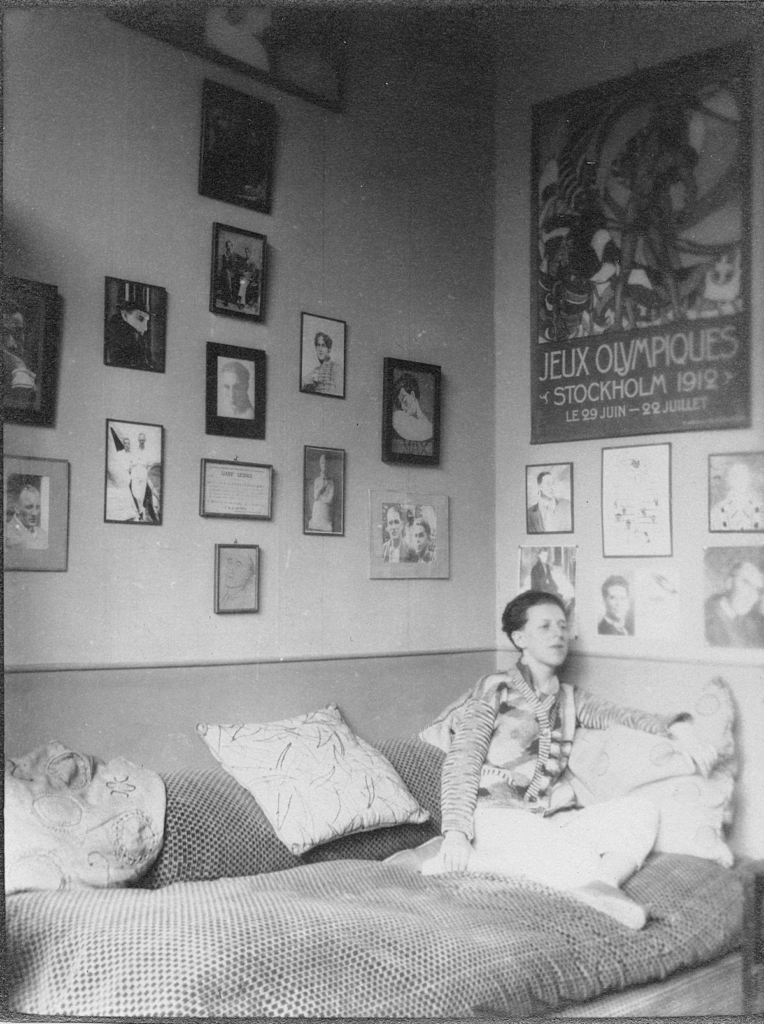 Interior of apartment at 22 rue Notre-Dame-des-Champs, Paris. Courtesy of the Jersey Heritage Collections.
Interior of apartment at 22 rue Notre-Dame-des-Champs, Paris. Courtesy of the Jersey Heritage Collections.
The saying “behind every successful man is a woman” has long summed up intimacy’s importance to creativity. The British philosopher John Stuart Mill believed as much, repeatedly noting that his most penetrating ideas were as much the work of his wife, Harriet Taylor Mill, as they were his. Of his still-influential 1859 essay On Liberty, he noted that it “was more directly and literally our joint production than anything else which bears my name, for there was not a sentence of it that was not several times gone through by us together, turned over in many ways, and carefully weeded of any faults, either in thought or expression, that we detected in it.”
Suzanne said the same of herself and Lucy: “When it comes to people who have played and worked together from childhood, and made a habit of discussing everything together, it becomes quite impossible to trace back the origin of a particular idea to one of them rather than the other.”
__________________________________
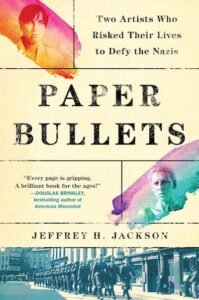
Paper Bullets: Two Artists Who Risked Their Lives to Defy the Nazis by Jeffrey H. Jackson is available via Algonquin Books.

